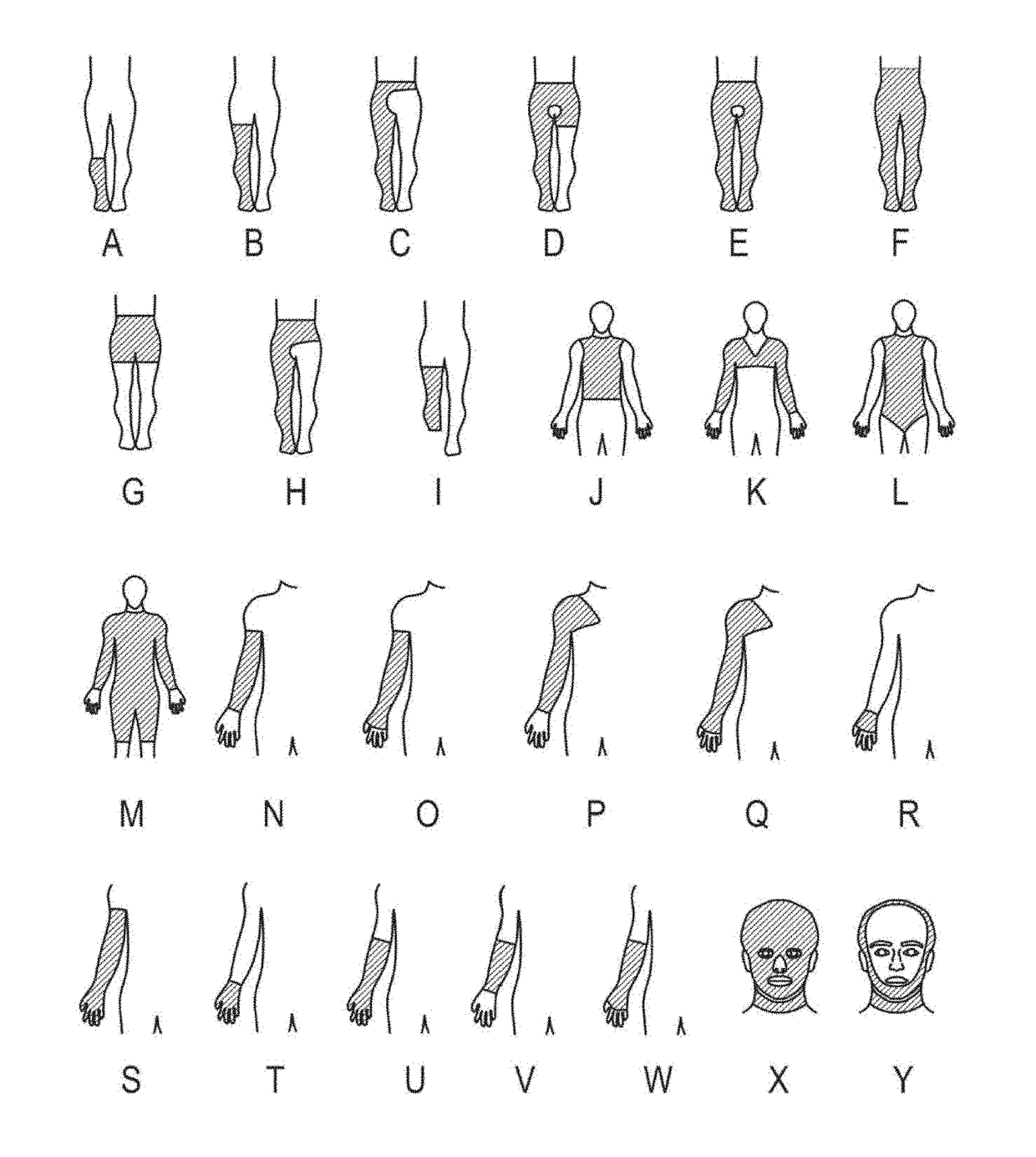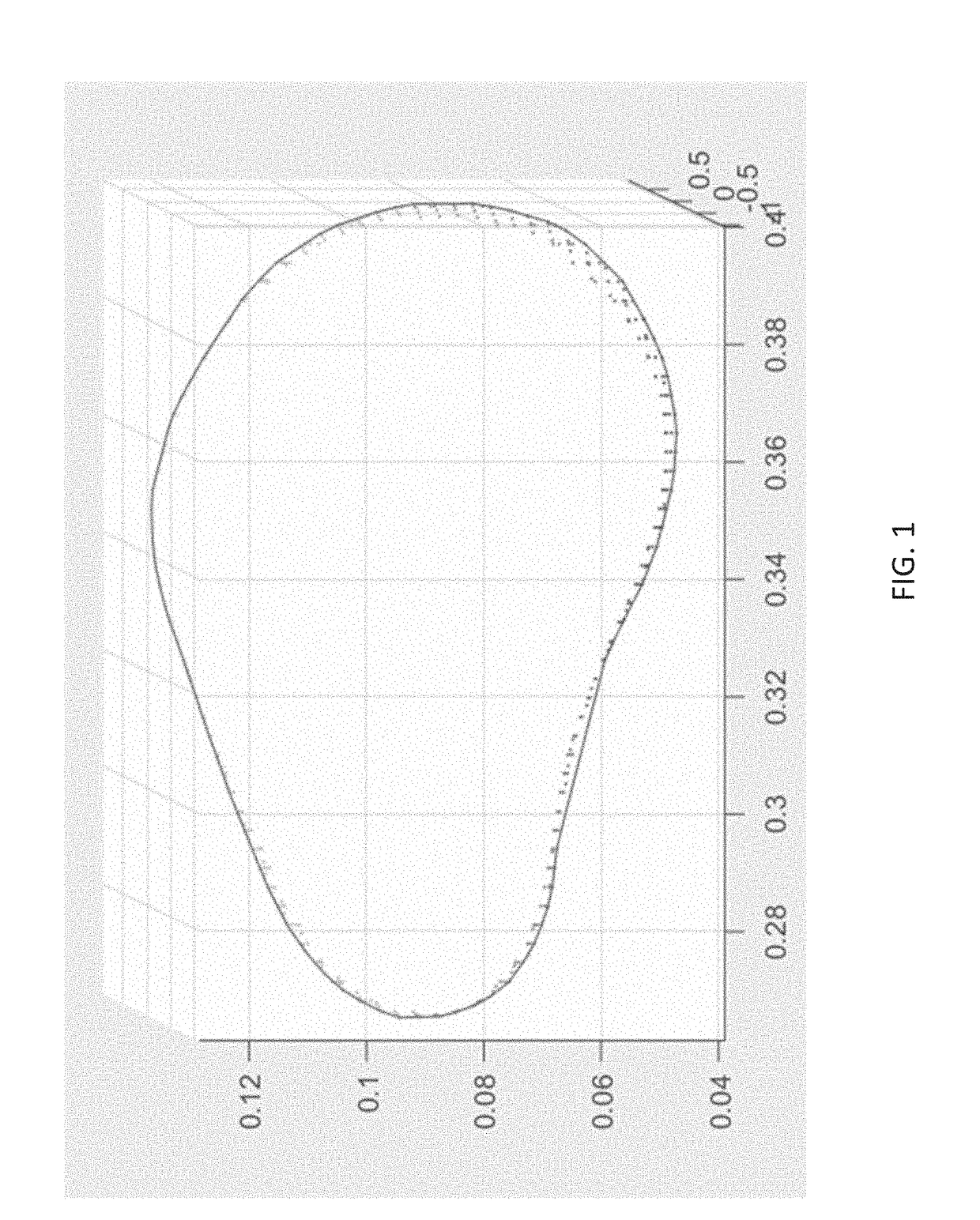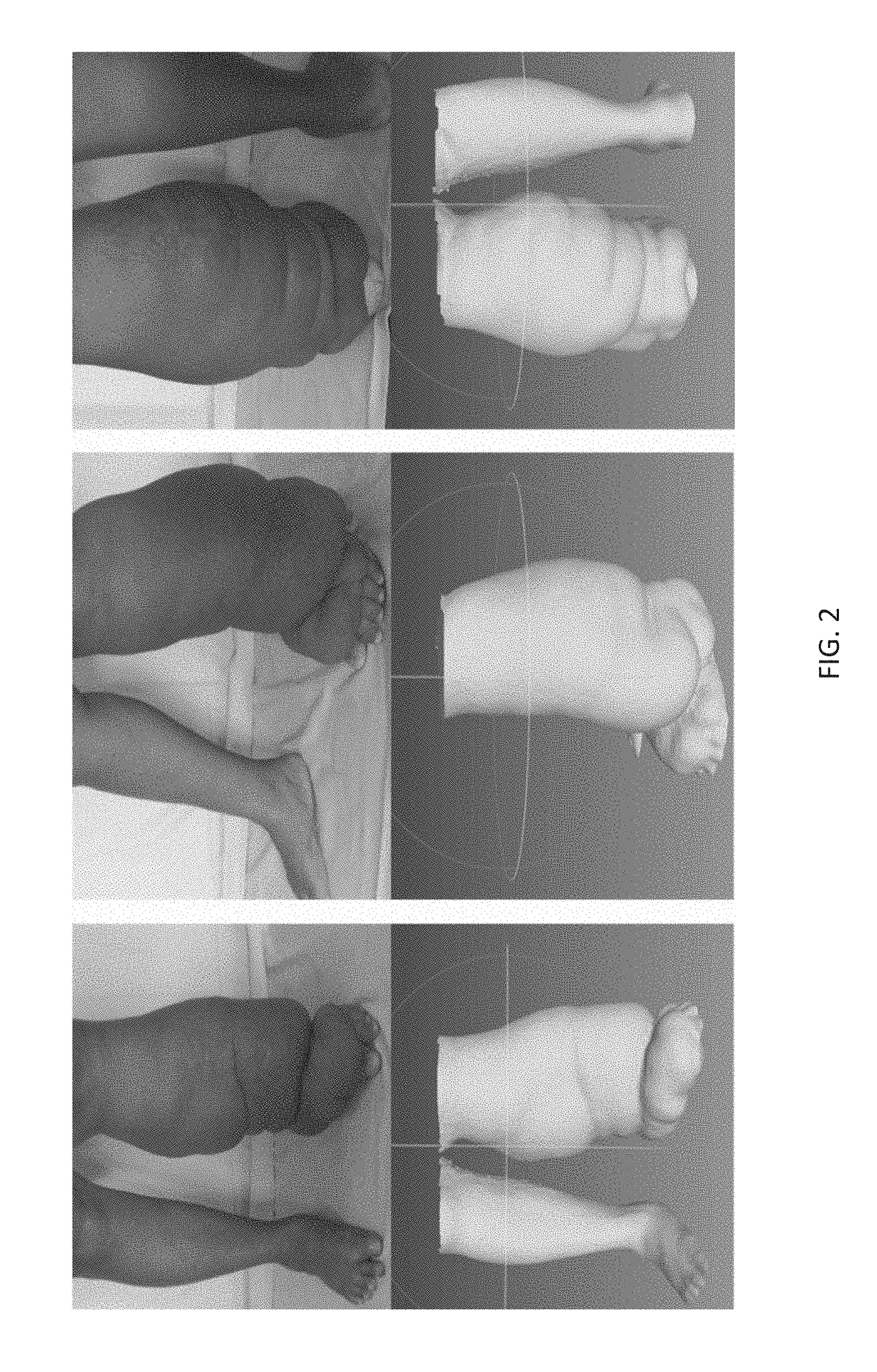As
edema increases, there is more potential for this “
cascade effect” to continue, to result in even more damage.
Existing methods of fitting compression garments for a specific patient are problematic, however.
As would be understood,
human body parts or body areas that may be fitted with compression garments are not regularly shaped, and some may be quite complex in
surface shape or morphology, such as in patients with advanced
lymphedema or those who are morbidly obese, for example.
A
compression garment may provide proper compression characteristics, but if the wearer experiences discomfort due to pinching, chaffing, buckling, or other reasons, she is unlikely to be compliant in wearing the
compression garment and, thus, may not achieve therapeutic benefits.
Commonly cited reasons include, among other things, pain, discomfort, difficulty donning the stockings, perceived ineffectiveness, excessive heat, and
skin irritation.
Of course, if a patient fails to wear a
compression garment that is prescribed for a potentially chronic or already
chronic condition, that condition can become worse and, perhaps, irreversible damage could result.
While tape measurement techniques are widely available to a broad scope of medical providers, the technique generally suffers from poor accuracy.
In short, tape measurement is not a very effective garment measurement tool because the technique has been shown to exhibit as much as an about 8 to about 12% inaccuracy due to inter and intra-operator variability.
In therapeutic settings, patients often receive a recommendation for a
custom fit garment, even though a
custom fit garment is often far more expensive than an pre-fabricated compression garment.
As noted, the current methodology used to fit compression garments is often inaccurate.
Thus, using current fitting methodology, even expensive
custom fit garments may not fit properly even when they are new.
This means that, once the garments are sent back from the manufacturer, the fit quality must be checked by the
technician and / or medical provider to make sure that the fit is therapeutically correct, thus necessitating further delays and increased cost in ensuring proper
patient treatment.
For chronic conditions, such as
lymphedema or diabetic limb indications, such
delay can cause irreversible harm to the patient.
As a general rule, compression garments are usually only guaranteed to be therapeutically effective for a life of six months, this cycle must be repeated regularly, which can reduce
patient compliance, as well as greatly adding to the
cost of treatment given the high amount of in-person time a patient requires to ensure proper fit of the compression garment.
The question of fit, or more specifically, the degree of compression provided by compression garments to
athletes, is a common issue that has been raised in the
peer review process and literature regarding the variable results.
Specifically, a large majority of studies have not measured the exact amount of compression that study participants are receiving.
If compression is not optimized, then the garment cannot provide
effective action to an athlete, regardless of whether that compression can actually make any physiological difference to an athlete.
In other words, the absence of consistent scientific data showing that compression garments are genuinely effective for assisting
athletes is confused by the fact that compression garments that apply adequate compression for an athlete in need of compression have not been part of existing study protocols.
Indeed, the fit of a compression garment for use by an athlete is critical: if compression in that athlete is not optimized, then the garment cannot do what it is proposed to do regardless of whether that compression can actually make any physiological difference to an athlete.
While it is possible that an optimal degree of pressure(s) that elicits beneficial or better effects for athletic performance, there does not exist in the prior art a valid and reliable
scientific method to measure the pressure at the garment-
skin interface.
While several studies reported attempts to quantify the degree of compression, these studies generally failed to report the reliability of these measurements.
Moreover, attempts to measure compression have occurred at a small number of easily accessible sites that are not representative of the net compression over the entire limb.
The cost of such “bespoke” compression garments generally likely exceeds the perceived value of the garment for most people, however, especially when coupled with the current lack of scientifically reliable data on the use of compression garments in treating
recovery after athletic activity.
Moreover, as in the
clinical treatment of
edema-like conditions, existing methods of generating custom compression garments cannot accurately measure the shape of a body part in need of compression along the entire surface thereof.
This leads again back to the issue of not knowing whether compression garments are actually beneficial to
athletes because it has been too difficult to generate compression garments that can, in fact, apply therapeutic amounts of compression to an athlete.
In short, the fit of the compression garment is an important factor in how effective such a garment will be to an athlete and without such fit, the
therapeutic effectiveness thereof will remain questionable.
Whether for therapeutic or athletic-type applications, when selecting pre-fabricated compression garments, a person is often left with insufficient information when trying to identify the appropriate compression garment.
This circumference range is often large, which may make it more difficult to understand the compression provided by the garment, especially beyond an initial distal measurement.
As a result, the user may end up with ill-fitting compression garments that, at best, provide limited benefits, and, at worst, can end up causing harm to the user.
Further, even if a
consumer or clinician has a compression chart with detailed compression information for a particular compression garment design, the fitting of compression garments may still be problematic.
It can be difficult to decide upon a size and compression class that will meet all specifications of a particular individual.
Individuals may also have specific characteristics, such as compression sensitivity and varying degrees of swelling in various limb locations, bony projections, etc., which can create even greater complexity in the selection process.
The true external shape of the body part or body area, called “morphology” herein, being fitted for compression garments will be difficult to reproduce using the standard compression garment fitting method of using a
tape measure.
Since large variations in body part shape can be seen in short distances along the surface of a body part, the conventional tape measurement method cannot generate a shape for the body part or body area being fitted.
As such, many custom fitted compression garments often do not provide the desired amount of compression along the whole of the body part or body area being treated with the compression garment.
More recently, three-dimensional imaging of a body part or body area has been proposed, however, such methods have not been found to provide clinically accurate reproductions, as discussed in more detail hereinafter.
Such “custom-fit” garments have traditionally been available only from tailors or seamstresses, and have accordingly been quite expensive and therefore generally out of reach of the average clothing
consumer.
Yet further, the lack of regulated sizes in the clothing industry makes it difficult for a person to know whether a particular garment will fit her.
This not only makes trying on clothes in a retail establishment
time consuming for shoppers, but also makes purchase of clothing online particularly challenging.
 Login to View More
Login to View More  Login to View More
Login to View More 


